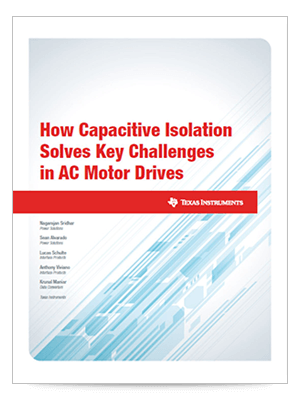SSZT384 november 2019 AMC1302 , ISO1211 , ISO1212 , UCC23513
Every day, we see systems in motion all around us, driven by motors.
AC motor drives are the most common type of motor drive. They’re used in a variety of industrial applications, such as air conditioning in commercial buildings and factory automation equipment.
These industrial applications operate at high voltages (typically 400 V and above) and power levels (typically kilowatts or megawatts), so it is imperative that considerations are made for the safety of human operators and expensive electronics.
Isolation is a critical part of creating safe AC motor drive systems and is governed by the International Electrotechnical Commission (IEC) 61800-5-1 safety standard; for more information on the isolation requirements for your system, see the white paper, “Isolation in AC Motor Drives: Understanding the IEC 61800-5-1 Safety Standard.” Isolation is commonly used for any signal or power transfer between the high- and low-voltage parts of a system, such as isolating gate drivers in the power-stage module or isolating feedback signals and communication interfaces in the control module.
Achieving Isolation in AC Motor Drives
There are many isolation solutions available on the market today, but not all isolation technologies are created equal in terms of reliability, lifetimes and thermal performance. One of the oldest isolation technologies is optical isolation used in optocouplers, also referred to as photocouplers or optoisolators. While ubiquitous and cheap, the performance of these optocouplers often frustrates system designers who need reliable solutions they can count on to operate effectively over the lifetime of a motor drive. Optocouplers tend to be limited to low data rates and temperatures, with higher-performing optocouplers being significantly more expensive. In addition, the LED design inherently leads to degradation over time – affecting the timing and reliability characteristics of the system and causing significant device-to-device variation, even among devices in the same lot.

Learn more about the advantages of capacitive-based isolation in the white paper, “How Capacitive Isolation Solves Key Challenges in AC Motor Drives.” This white paper discusses how our isolation portfolio helps you overcome challenges related to outdated optocoupler solutions.